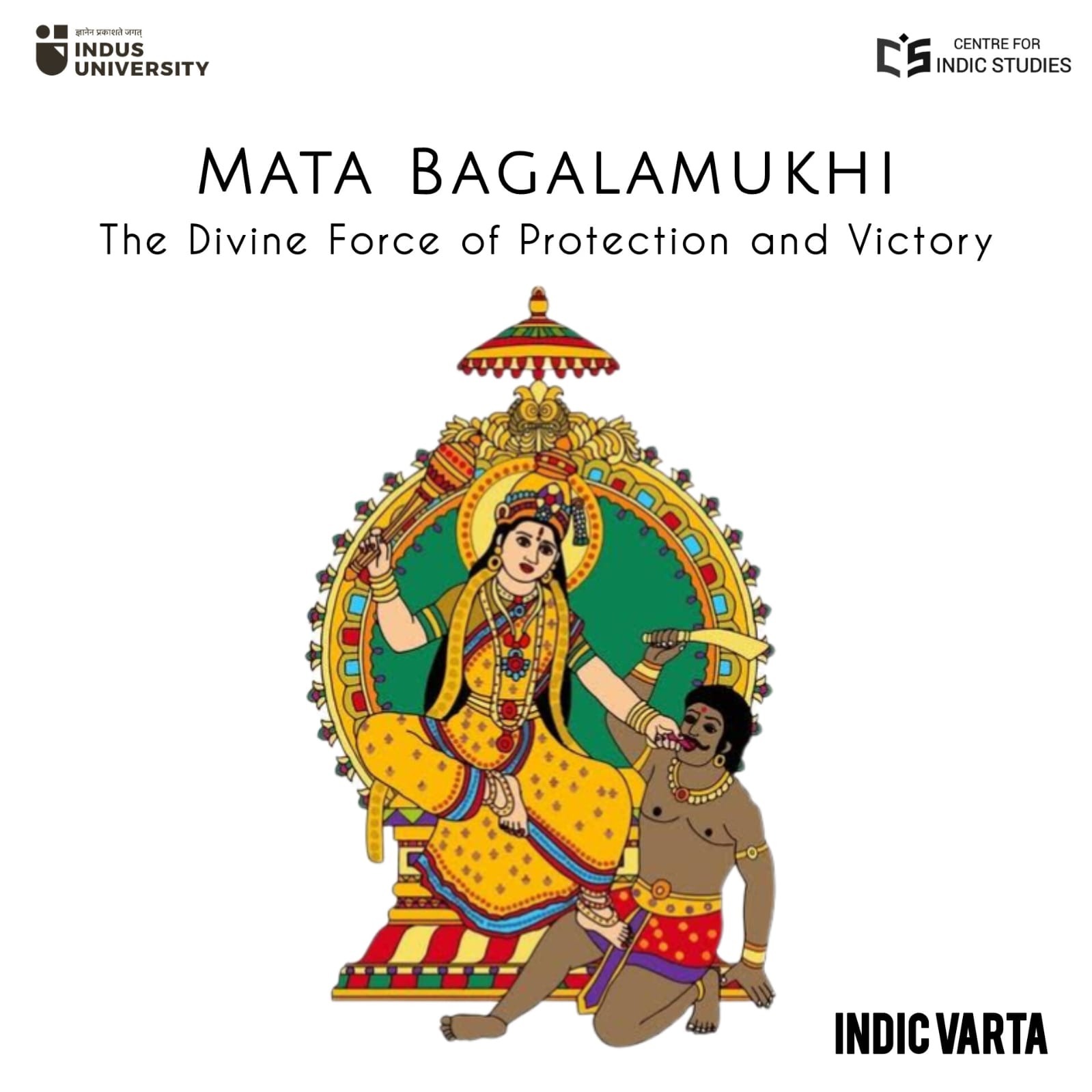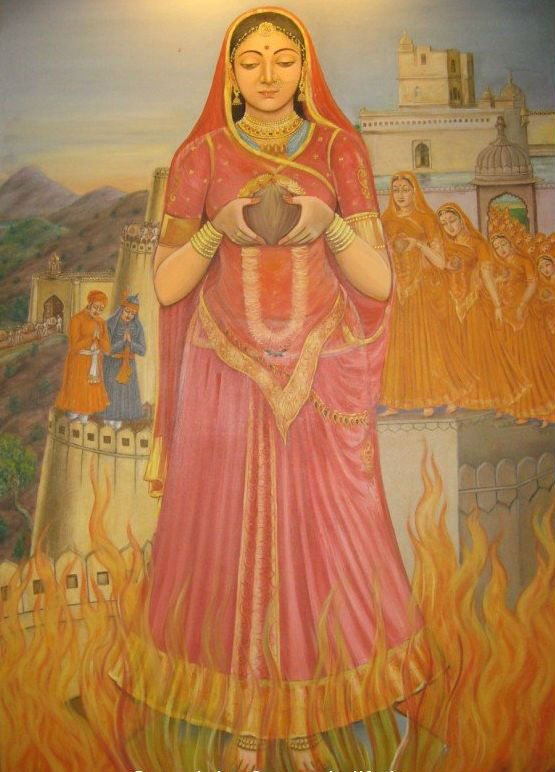- Visitor:141
- Published on: 2025-05-05 05:56 pm
Mata Bagalamukhi: The Divine Force of Protection and Victory
Mata Bagalamukhi's iconography is one of the most visually and symbolically powerful among the ten Mahavidyas of Hinduism. Each element of her depiction serves as a profound spiritual metaphor, representing her role as the controller of harmful forces, both internal and external. She is typically illustrated as a two-armed goddess seated on a majestic golden throne, surrounded by a sea of yellow lotuses. This divine setting not only enhances her regal presence but also reflects her deep association with the color yellow—a symbol of purity, wisdom, clarity, and transcendence.

Mata Bagalamukhi, also known as Bagalamukhi or Pitambara Devi, is one of the ten Mahavidyas in Hindu Tantra, revered for her formidable powers of protection, victory over adversaries, and the ability to neutralize negative energies. Her worship is integral to Tantric practices, particularly for overcoming obstacles, legal disputes, and achieving success in endeavors. This article delves into the multifaceted aspects of Mata Bagalamukhi, encompassing her origin, symbolism, rituals, and the profound impact of her worship on devotees.
In the vast and intricate history of Hindu spirituality, Mata Bagalamukhi holds a revered and distinctive place among the ten Mahavidyas, the powerful forms of the Divine Mother. She is widely venerated as the goddess of stillness, silence, and supreme control—particularly over enemies, evil forces, and the wandering mind. Her name is deeply symbolic, with 'Bagala' derived from the Sanskrit root valga, meaning "bridle" or "to restrain," and 'Mukhi' meaning "face" or "mouth." Together, the name signifies "She whose face has the power to immobilize or paralyze," underscoring her role as a divine force capable of stopping negative speech, actions, and intentions in their tracks.
Often portrayed with a serene yet commanding yellow form, Mata Bagalamukhi is also known as Pitambara Devi. The color yellow is not merely decorative; it represents knowledge, clarity, and wisdom—qualities essential for overcoming confusion and delusion. Devotees often wear yellow clothes, offer yellow flowers, and perform rituals with turmeric during her worship to align themselves with her divine energies. Her image typically shows her gripping the tongue of a demon while raising a club, symbolizing the subjugation of harmful speech and actions.
Worship of Mata Bagalamukhi is especially popular among those seeking victory in legal matters, protection from slander, and freedom from internal and external enemies. Beyond material concerns, she also represents the inner power to silence doubt and stabilize the mind in deep meditation. As both protector and granter of success, Bagalamukhi embodies the transformative power of divine stillness—the ability to overcome through inner control and divine will. Her worship is a call to harness speech, thought, and action in alignment with truth, making her a central figure in both spiritual and worldly pursuits.
Origins and Mythological Background
The origin of Mata Bagalamukhi is deeply embedded in the esoteric traditions of Hindu Tantric scriptures, where she is revered as one of the ten Mahavidyas—powerful manifestations of the Divine Mother, each representing a cosmic truth. Her emergence is tied to a time of great cosmic upheaval. According to legend, the universe was once besieged by violent storms, floods, and widespread chaos, threatening the balance of creation. In desperation, the gods and sages turned to the Supreme Divine Feminine, invoking her grace and protection through intense penance and devotion.
Answering their call, Mata Bagalamukhi arose from the depths of the sacred Haridra Sarovar, or Turmeric Ocean, a mystical lake said to shimmer with golden light. Her form was radiant, dressed in yellow garments, with a golden aura that dispelled the swirling darkness. As she emerged, her divine energy brought stillness to the raging storm, symbolizing her unparalleled power to halt and neutralize negative forces. This moment marked her as the deity of stambhana—the mystical power to paralyze or immobilize evil, deception, and conflict.
Mata Bagalamukhi’s association with the color yellow—signifying purity, wisdom, and spiritual knowledge—further connects her with enlightenment and clarity. Geographically, her worship is believed to have originated in the ancient Saurashtra region and along the sacred Narmada River, both centers of early tantric practices. Over time, her veneration spread widely, and today she is especially worshipped in powerful shakti peethas across India. Prominent temples dedicated to her are located in Ujjain (Madhya Pradesh), Datia (Madhya Pradesh), Kamakhya (Assam), and Kangra (Himachal Pradesh), each drawing thousands of devotees seeking protection, justice, and spiritual empowerment.
Mata Bagalamukhi thus stands as a potent symbol of divine intervention in times of crisis—restoring order through her transformative, commanding presence.
Symbolism and Iconography
Mata Bagalamukhi's iconography is one of the most visually and symbolically powerful among the ten Mahavidyas of Hinduism. Each element of her depiction serves as a profound spiritual metaphor, representing her role as the controller of harmful forces, both internal and external. She is typically illustrated as a two-armed goddess seated on a majestic golden throne, surrounded by a sea of yellow lotuses. This divine setting not only enhances her regal presence but also reflects her deep association with the color yellow—a symbol of purity, wisdom, clarity, and transcendence.
Clad in vibrant yellow garments, Mata Bagalamukhi is also known as Pitambara Devi, meaning "the goddess draped in yellow." The color yellow in Hindu tradition holds immense spiritual significance. It is the color of turmeric, the sacred spice used in rituals for purification and protection, and it symbolizes knowledge, learning, and mental clarity. Her golden-yellow complexion radiates a divine luster, emphasizing her power to dispel darkness, ignorance, and negativity.
One of the most defining aspects of Mata Bagalamukhi’s iconography is her unique posture and the objects she holds. On one hand, she wields a gada (club), representing divine authority, strength, and the power to destroy evil. On the other hand, she is shown seizing the tongue of a demon, immobilizing him in the act of wrongdoing. This potent gesture captures her primary attribute—stambhana shakti, the mystical power to paralyze or restrain. She has the power to silence malicious speech, halt harmful actions, and neutralize negativity at its source.
This symbolic act transcends the literal and enters the realm of psychological and spiritual transformation. The demon represents uncontrolled desires, ego, anger, jealousy, and harmful intentions. By grasping his tongue, the goddess demonstrates her ability to subdue these inner enemies, guiding the devotee toward self-control, mental discipline, and spiritual awareness. Her club, meanwhile, signifies the will and courage needed to face and overcome both internal struggles and external adversaries.
Together, these elements depict Mata Bagalamukhi not as a goddess of destruction, but as a divine force of restraint, protection, and transcendental silence. She teaches that true strength lies in control—not in aggression, but in the ability to master one’s speech, thoughts, and actions. Her imagery serves as a powerful reminder that spiritual victory often begins with silence, introspection, and the inner power to restrain negative tendencies.
Rituals and Worship
The worship of Mata Bagalamukhi is a deeply sacred and powerful practice rooted in Tantric traditions. Unlike more commonly followed devotional paths, her Sadhana requires intense focus, discipline, and often the guidance of a knowledgeable guru. She is especially invoked during times of conflict—legal battles, disputes, slander, or when one is surrounded by enemies or facing obstacles that threaten peace, reputation, or success. Her worship is aimed not only at external protection but also at the inner conquest of destructive thoughts and emotions.
Key Aspects of Worship
1. Yellow is the Sacred Color:
Yellow is the most significant color in Bagalamukhi worship. It symbolizes clarity, purity, and divine wisdom—qualities that align closely with the goddess’s energy. Devotees wear yellow garments, decorate the altar with yellow flowers such as marigold or sunflower, and offer yellow foods like turmeric-infused rice, saffron milk, and gram flour sweets. Even the offerings used in fire rituals (Homa) are typically yellow in color—such as turmeric, yellow mustard seeds, and clarified butter (ghee)—enhancing the vibrational resonance of the ritual.
2. Mantras and Sadhana:
At the heart of her worship lies the recitation of potent mantras. Among them, the most widely practiced is the Bagalamukhi Beej Mantra:
“ॐ ह्लीं बगलामुखि सर्वदुष्टानां वाचं मुखं पदं स्तम्भय जिव्हां कीलय बुद्धिं विनाशय ह्लीं ॐ स्वाहा।”
This mantra invokes the goddess's power to Stambhana (paralyze) harmful speech, actions, and intentions. Repetition (Japa) of this mantra is often done with a rosary (mala) of turmeric beads, typically in multiples of 108, to amplify spiritual force and intention. For deeper practice, Anusthan (intensive ritual practices over a set number of days) is performed under strict discipline.
3. Night Worship and Amavasya:
Many of Mata Bagalamukhi’s rituals are conducted at night, especially on Amavasya (new moon), which is believed to be the most potent time for Tantric practices. The silence and spiritual intensity of night enhances the connection with her energy, allowing practitioners to dive deep into meditation and mantra recitation. These sessions are typically performed in secluded or consecrated spaces to minimize disturbance and strengthen concentration.
4. Yantra and Homa (Fire Rituals):
The Bagalamukhi Yantra, a geometric diagram infused with her mantra, is used as a focus for meditation and energy transmission. Worship of this yantra, either on paper, metal, or engraved on a sacred surface, is considered a direct way to invoke her presence. In advanced rituals, homas (fire offerings) are performed using ingredients such as ghee, yellow mustard seeds, turmeric, and sandalwood. These fire rituals are said to purify the surroundings, invoke divine presence, and remove obstacles from the practitioner’s path.
5. Spiritual Discipline and Vows:
True worship of Mata Bagalamukhi requires strict self-discipline. Devotees often take vows of celibacy, silence (mauna), fasting, and mental purity during the period of her sadhana. Silence, in particular, holds a special place in her worship, aligning with her ability to silence enemies and inner chatter alike. This disciplined lifestyle helps channel the practitioner’s energy inward, allowing for a deeper communion with the goddess.
In essence, the rituals of Bagalamukhi are not merely external ceremonies—they are intense spiritual practices that demand inner transformation. Through dedication, purity, and focused intention, devotees seek not only worldly victories but also liberation from fear, confusion, and inner turmoil. Her worship, when performed with sincerity and care, becomes a powerful means of invoking divine justice and spiritual awakening.
Spiritual Benefits
Mata Bagalamukhi is not only a goddess of mystical power but also a profound embodiment of strategic control, mental discipline, and inner transformation. Among the ten Mahavidyas, she is especially revered for her unique ability to bring stillness in the midst of chaos—both in the outer world and within the inner landscape of the human mind. Her worship offers spiritual depth, making her revered by both worldly aspirants and sincere seekers of truth.
For true spiritual aspirants, she is the Goddess of Inner Silence and Control—qualities essential for authentic spiritual progress. Her blessings aid in:
Silencing the ego: The grasping of the demon’s tongue in her iconography represents control over the restless ego and harmful speech. Worshipping her gradually stills the reactive mind, taming pride, arrogance, and impulsiveness.
Mastery over speech and thought: In Tantra, mastery over vak (speech) and manas (mind) is a prerequisite for higher states of awareness. Bagalamukhi grants this discipline, helping one speak truthfully and think clearly.
Enhancing mental focus and stability: Her presence brings deep mental clarity and the strength to stay grounded during times of confusion, fear, or emotional upheaval.
Developing fearlessness: As a goddess who faces down evil directly, she instills courage and inner fortitude in her devotees, empowering them to face challenges without anxiety or doubt.
Symbol of Meditative Stillness
Perhaps most importantly, for the yogi or meditator, Mata Bagalamukhi symbolizes the power to still the mind, which is essential for entering the deeper stages of dhyana (meditation) and samadhi (deep meditation). The inner silence she grants is not emptiness, but a vibrant stillness—free of distraction, ego, and mental noise—where the truth of the Self can be realized.
In this sense, her power is transformative. She is not merely a protector against external enemies, but a remover of the greatest enemy of all: the restless, untrained mind. In her grace lies the path to both worldly success and spiritual liberation, making her a truly multidimensional and revered deity in the Hindu Tantric tradition.
The Deeper Tantric Wisdom
Mata Bagalamukhi is often misunderstood as merely a fierce, enemy-subduing goddess, but in the deeper realms of Tantra, she represents something far more profound—the stilling power of ultimate consciousness, the divine silence that dissolves illusion (maya) and reveals the truth of existence. As one of the ten Mahavidyas, she embodies not just protective force but also transformative wisdom, guiding the practitioner beyond the realm of duality into the light of pure awareness.
In the Tantric tradition, Bagalamukhi's primary attribute—stambhana shakti, the power to immobilize or paralyze—is not considered a force of destruction, but one of spiritual alchemy. She halts the constant motion of the mind, the endless chatter of thoughts, and the restless pull of desires. In doing so, she allows the practitioner to witness the illusory nature of the world and the ego. This suspension of activity is not suppression, but a conscious withdrawal of energy from illusion toward truth.
Her grip on the demon's tongue is symbolic not just of silencing enemies, but of silencing the inner critic, the false ego, and harmful speech rooted in ignorance. Through this symbolic act, she invites the devotee to recognize the power of silence—not as absence, but as presence. In this sacred stillness, true knowledge (jnana) arises, and the seeker can experience the self beyond body, mind, and emotion.
Bagalamukhi thus serves as the guardian at the threshold of moksha (liberation). She stops the outward flow of consciousness and turns it inward, directing it toward the eternal Self. In this way, her energy becomes a bridge—from worldly entanglement to spiritual freedom, from chaos to inner harmony.
In essence, the deeper wisdom of Bagalamukhi lies in her ability to transform paralyzing fear into fearless stillness, ignorance into insight, and noise into silence. Her path is not one of violence, but of power rooted in awareness—a reminder that sometimes, the greatest strength lies in stillness.
The Profound Importance of Bagalamukhi Jayanti
Bagalamukhi Jayanti is not just a celebration of the goddess’s appearance—it is a deeply transformative moment in the spiritual calendar, revered by seekers, devotees, and Tantric practitioners alike. Observed on the auspicious Ashtami Tithi of the Shukla Paksha in the month of Vaishakha, this day commemorates the divine emergence of Mata Bagalamukhi from the Haridra Sarovar to restore balance during a time of cosmic disorder. It is on this sacred day that her energy is believed to be most accessible, most responsive, and most potent for those who seek her protection, guidance, and blessings.
The significance of Bagalamukhi Jayanti goes far beyond ritual. It serves as a potent reminder of her unique Shakti—the power to still, paralyze, and dissolve negativity in all its forms. For those facing legal battles, conflicts, defamation, or malicious opposition, this day offers an opportunity to invoke her divine assistance and emerge victorious. For spiritual aspirants, it is a time to internalize her deeper symbolism: the mastery over speech, the silencing of the ego, and the ability to enter a space of profound inner silence. Her worship on this day acts as a spiritual pause—a moment where the chaos of life is held at bay, allowing the devotee to reflect, recenter, and reconnect with the eternal truth within.
Special pujas, homas, mantra chanting, and yantra worship performed on Bagalamukhi Jayanti are said to bear manifold fruit. The observance of vows, celibacy, fasting, or silence during her sadhana further intensifies the spiritual merit gained. For those devoted to the goddess, this is a time not just to ask for protection, but to surrender ego, fear, and mental agitation at her feet, trusting in her power to neutralize both seen and unseen enemies.
In essence, Bagalamukhi Jayanti is a celebration of divine stillness in the midst of worldly noise—a chance to anchor oneself in the unshakable presence of the goddess who controls not through force, but through the supreme power of awareness and silence. Observing this sacred day with devotion, discipline, and humility opens the door to both outer success and inner liberation, fulfilling the dual promise that Mata Bagalamukhi holds for all her devotees.
- 70 min read
- 4
- 0










